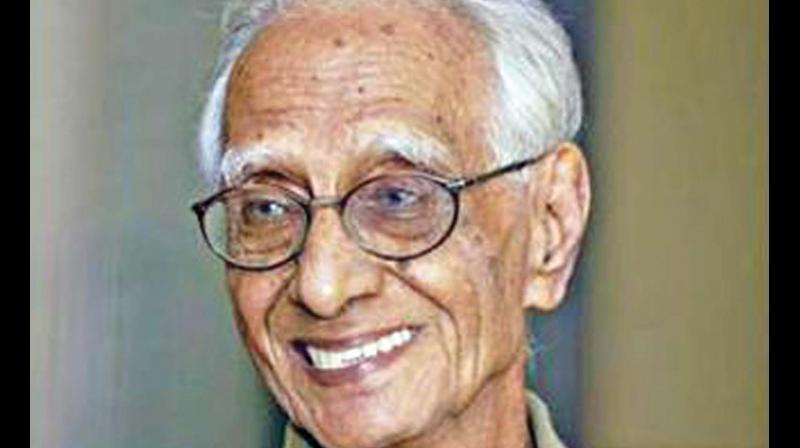Pulling down Babri Masjid was no way of settling scores: Ashokamitran

Chennai: It was sometime in the third week of November 2002. The voice, at the other end of the telephone, of the eminent Tamil writer and Sahitya Akademi Award wnner, Sri. Ashokamitran was soft and clear.
“If you are coming from Guindy towards Velachery, you first see Dandeeshwaram temple. Then to your left is the Dandeeshwaram bus stop. From there you take your first left, it is Dandeeshwaram Main Road, then you turn second right to Dandeeshwaram Nagar First Main Road,” and so on. His cartographic sense and precision was amazing, like a GPS software today.
I was awestruck with the neat set of descriptions he sequentially rolled out with a musical rhythm on how to reach his house with ‘Dandeeshwaram’ prefix in almost every turn. I followed his roadmap to the last dot, and there I was at the gate of his modest apartment building in this South Chennai middle class suburb. He was then living with his youngest son T Ramakrishnan, a journalist.
That was when I was working as Tamil Nadu correspondent for ‘The Telegraph’ and had sought an appointment to meet him to convey a request from my then Features Editor, Gouri Chatterjee in Calcutta, that he write a piece on how he felt about the demolition of the Babri Masjid in Ayodhya, as come December that year, it was the tenth anniversary of that horrific game-changer in contemporary Indian politics.
After the formal introduction, as I sought to broach the issue, Ashokamitran quickly put my listlessness to ease. There was absolutely no airs about him, despite his already stupendous achievements as a Tamil writer and translated widely into other languages.
Tamil writing being his first love, when I mentioned that the Newspaper wanted an article on the Babri Masjid issue ahead of the tenth anniversary, he grimaced a bit, mirroring his reluctance to write in English, though a fluent writer in both the languages. I then told him “Calcutta valued his thoughts more than Chennai”. He gave me an amused look and then agreed to write.
Within a week, keeping tight line and length for an Op-Ed page piece, Ashokamitran came out with a beautifully well-knit piece in English that was to be titled, “The Flaw Is Not In The Structure”, published on December 4, 2002.
I collected his neatly typed manuscript and keyed his text in my office computer, taking great care to ensure that no error crept in the process before sending it to my office in Calcutta. As they were the views of an acclaimed Tamil writer from south on a weighty and sensitive issue, the messenger could ill-afford an error.
For a writer with a large body of work in Tamil, particularly in terms of his novels and short stories, this multifaceted reflection from Ashokamitran’s pen was indeed a rare piece of writing in itself. The article’s apparent simplicity was at best an entry-point to commend the piece to a wider readership.
More significantly, from a philosophical point of view, reading it several times over, one glimpsed that his piece was also a methodology of writing – both form and content that possibly suffused Ashokamitran’s substantial body of writing in Tamil over the years.
Every little observation of Ashokamitran, of people, places and various strands of what by then was called a ‘disputed structure’, whether it concerns religious belief of the Hindus and Muslims, or issues of archaeology and history, disciplines where the last word always eludes, is tested on unique grains of particularity. It showed how he was deeply rooted to empirical approach and everyday life-world.
Even the personal anecdotes, about his son’s marriage, during those politically stormy months of 1991-92 starting from former Prime Minister Rajiv Gandhi’s assassination in May 1991 to the “national cataclysm” of the Babri Masjid demolition on December 6, 1992, how in 1960, the “closest I got to the Masjid” was Allahabad and Varanasi when he had accompanied his three elderly aunts to perform ‘shradha’ for his ancestors-, Ashokamitran unpacked the complexity of the Babri Masjid dispute discourse by making it a confluence of the seemingly personal and the larger historical narrative, of the subject floating with the other. Finally, we all crisscross in a complex web of objective happenings. He shows this in his writing, rather than stating it in black and white.
Structurally, the proximity of a mosque ‘so close’ to a Hindu shrine, Ashokamitran wrote, “gave me moments of worry” even while visiting Varanasi itself, subtly flagging an elemental issue that so dangerously later fed into the ‘Ram Janmabhoomi Movement’.
Then the author adverts to his childhood days in Secundarabad, in the days of the Nizam, where the spirit of coexistence was, perhaps, felt more. Bells in a temple near the railway station would not chime, as people would say ‘hush’ and point to a mosque nearby.
After traversing all this complex topography of issues, in simple, ordinary language, without any rancour, Ashokamitran forthrightly concludes his piece saying: “The past is past and what is done is done. But still I feel the demolition of December 6 should not have taken place. That was no way of settling scores of what a man did 474 years ago.”
Ashokamitran wrote till his last days, says his son. On March 23 night, he had some ‘rice with rasam’ at the hands of his wife Rajeshwari and shortly later breathed his last. “Except for occasional bouts of asthma, he had no major illness,” says Ramakrishnan. But who has overcome old age and death? Another liberal soul has flown away.

